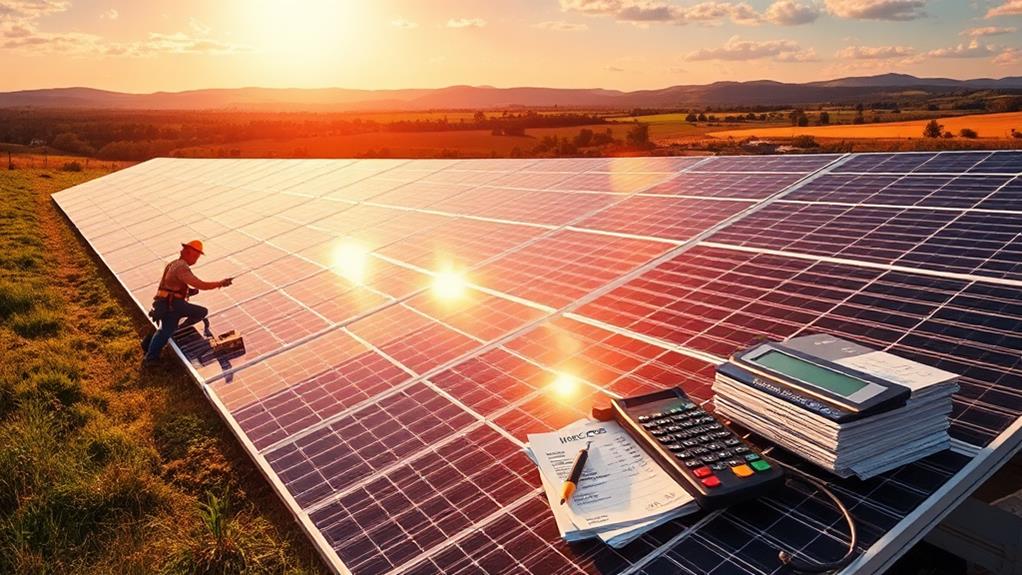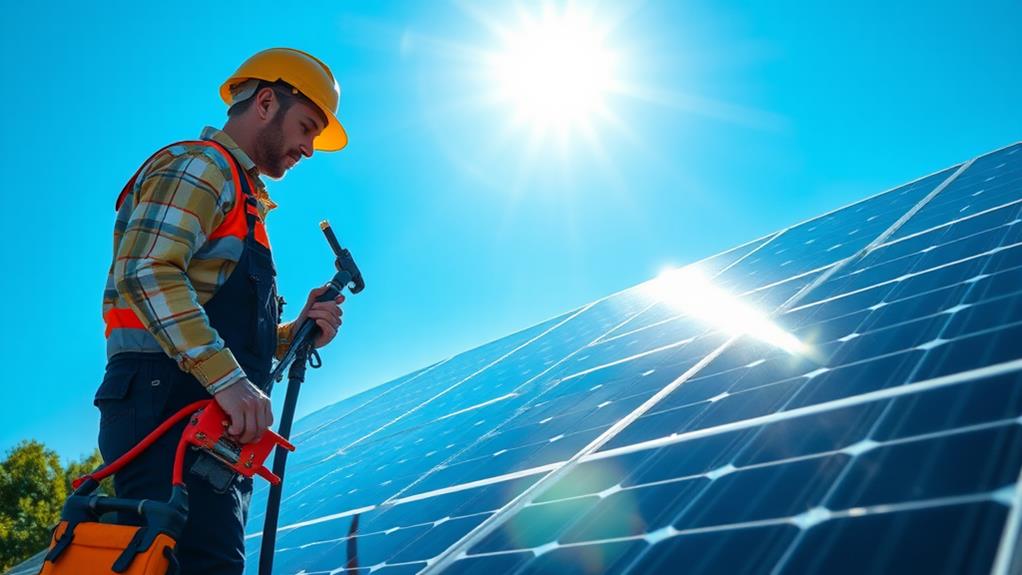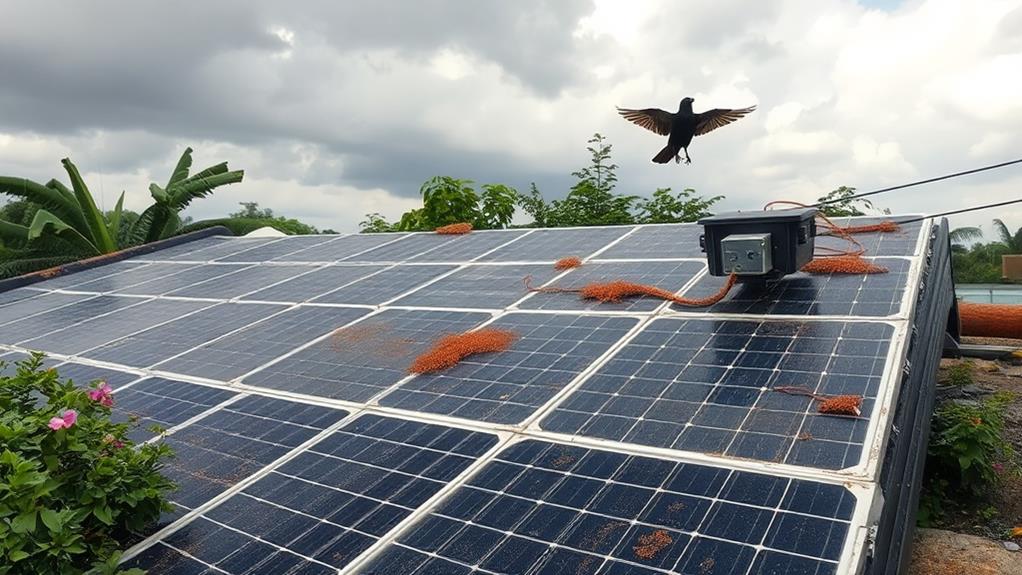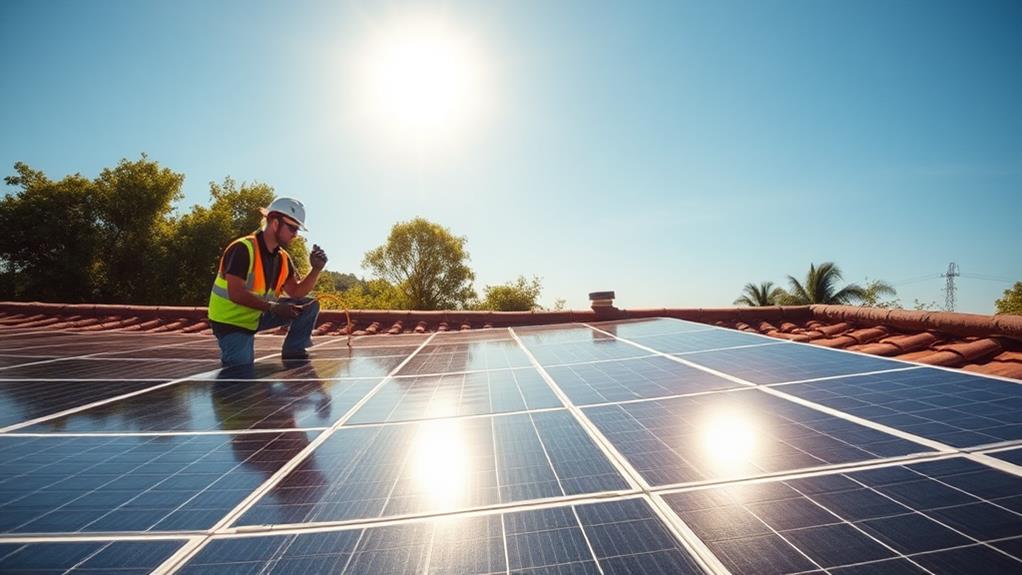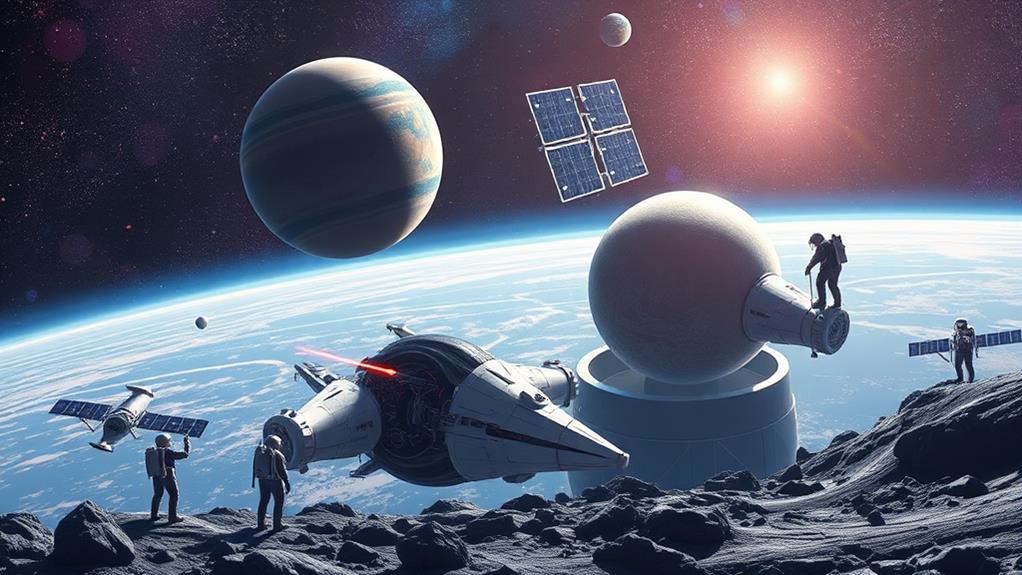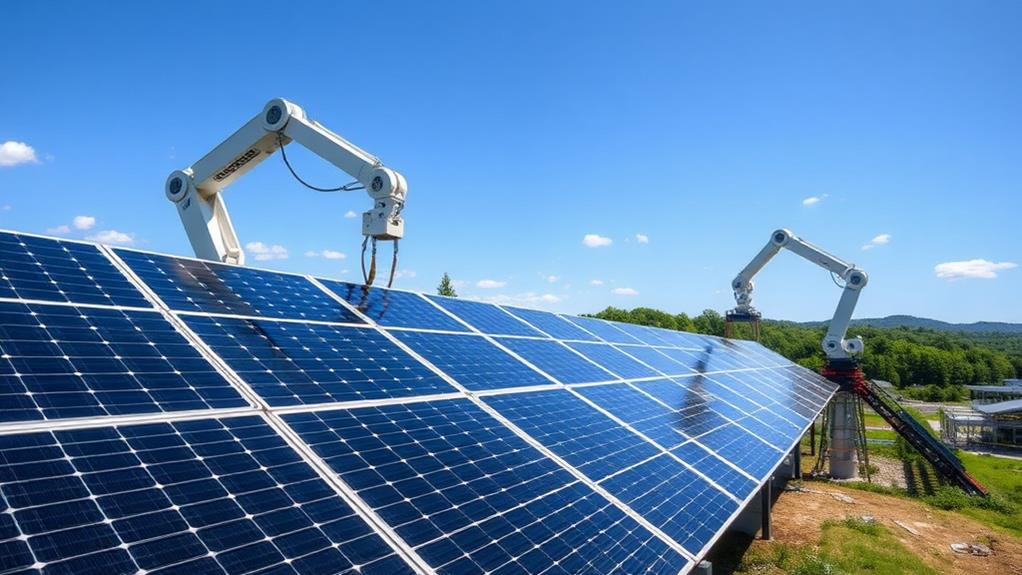Let's break down what it costs to get solar panels installed. We'll start with the solar panels themselves, which vary by type and brand, like Longi Solar's range, impacting your investment decision. Inverters are next, costing between R8,000 to R40,000, with hybrid options offering power during outages. For battery storage, consider lithium-ion models like the Tesla Powerwall for reliability and decreasing prices. Labor and installation fees range from ZAR 8,000 to ZAR 50,000, factoring in complexity. And don't forget additional equipment and potential government incentives. Curious about how these all add up to make solar a wise investment?
Key Takeaways
- Solar panel prices vary by type and capacity, with options from 275W to 610W.
- Inverter costs range between R8,000 and R40,000, influenced by type and features.
- Battery storage prices depend on capacity and brand, with lithium-ion options being popular.
- Labour and installation fees constitute 10-20% of total costs, typically ranging from ZAR 8,000 to ZAR 50,000.
- Installation complexity and quality of service significantly impact overall expenses.
Solar Panel Costs
When examining solar panel costs, investing in solar technology has become increasingly accessible over the years. In South Africa, residential solar panels are a practical option for households aiming for sustainability and long-term savings. Brands like Longi Solar offer panels ranging from 275W to 610W, providing various options to suit energy needs and budgets.
Different types of solar panels, such as Monocrystalline, Polycrystalline, Thin-film, Bifacial, and Integrated solar roof tiles, each offer unique benefits in terms of efficiency.
Monocrystalline panels are renowned for their high efficiency and sleek design, optimising energy production, particularly when space is limited.
Polycrystalline panels are generally more affordable and provide a good balance of efficiency and cost-effectiveness.
Thin-film panels are lightweight and flexible, suitable for varied applications.
The installation of solar panels is crucial for optimal performance. Properly installed panels capture maximum sunlight, enhancing efficiency and savings. Warranties often extend over 25 years, offsetting the initial cost with decades of reduced energy bills. This fosters a sense of community among those committed to sustainable living.
Inverter Pricing
Now let's discuss inverter pricing, an essential part of our solar installation adventure.
Inverters, with prices ranging from R8,000 to R40,000, come in different types and costs, and selecting the appropriate one depends on our system's requirements and budget.
We should take into account their effectiveness and characteristics, along with installation necessities, to guarantee we're optimizing our investment.
Types and Costs
Inverter pricing is an essential part of the overall cost of residential solar systems, with costs varying depending on the type and complexity. Understanding the different types of inverters can help make informed decisions that align with community values.
For instance, string inverters are often more economical and are a reliable choice for those seeking cost-effective solutions.
For higher efficiency and additional features, microinverters and hybrid inverters may be preferable. They offer advanced technology, albeit at a higher price.
Hybrid inverters, such as the GoodWe ES Series, provide battery backup, ensuring homes remain powered during outages, which can be invaluable. This feature comes at a premium compared to standard options.
When choosing the right inverter, consider not just the upfront cost but also the brand, quality, and power capacity to suit your solar system needs. Ensuring optimal performance for the long term is crucial.
Efficiency and Features
Although inverter pricing significantly impacts the overall cost of a solar installation, efficiency and features are crucial factors when making a decision. Selecting the right inverter technology is essential for maximising system performance and ensuring long-term benefits for the community. Different inverters cater to varying needs and budgets.
String inverters offer a cost-effective solution for smaller systems through centralised power conversion. They're ideal for simple installations seeking reliable performance.
For installations with shading or panel orientation challenges, microinverters provide individual panel optimisation, enhancing overall efficiency and system resilience. A recommended product for microinverters is the Enphase IQ7, known for its robust performance and durability.
Hybrid inverters represent the forefront of inverter technology. These units integrate grid-tied and battery backup capabilities, offering performance improvements that increase energy independence and system reliability.
The SMA Sunny Boy Storage inverter is a noteworthy option for those seeking a future-proof solution that adapts to evolving energy needs.
Inverter quality, efficiency ratings, monitoring capabilities, and warranty coverage are essential considerations. Making informed choices that balance cost with advanced features ensures solar systems serve well in the long term.
Installation Considerations
When assessing solar installation expenses, it's crucial to account for the effect of inverter pricing on the overall budget. The choice of inverter significantly influences both the initial costs and the long-term efficiency of solar power systems. Inverters vary in price, influenced by types such as string, micro, or hybrid inverters. Each type presents its own level of installation complexity and cost implications.
String inverters are generally more affordable, whereas micro inverters optimise performance for individual panels. Hybrid inverters, which include battery storage capabilities, are typically more expensive but offer the added advantage of energy storage. Selecting the appropriate inverter involves balancing upfront costs with potential future savings and efficiency gains.
Inverter pricing can form a substantial part of the total budget alongside panels and mounting systems. Quality is paramount, as a reliable inverter enhances system performance. A good option for a string inverter is the Fronius Primo, while Enphase Energy offers excellent micro inverters. For hybrid inverters, the GoodWe ES series is recommended for its integration with battery storage.
Informed inverter selection not only optimises installation complexity but also enhances returns on solar power investments, fostering a sense of community within the solar energy sector.
Battery Storage Expenses
When considering solar installation services, understanding battery storage expenses is essential for homeowners aiming for energy autonomy. Investing in battery storage can convert solar systems into more robust setups, enabling the storage of surplus energy for future use. Battery storage costs vary considerably, depending on the capacity and brand. A thorough brand comparison is crucial as some brands offer superior efficiency and lifespan, particularly when opting for the popular lithium-ion batteries, known for their reliability and long-term performance.
For those interested in reducing costs, examining DIY options might seem appealing. However, it's vital to weigh potential savings against technical challenges and maintenance needs. Proper maintenance and monitoring of battery systems are crucial to ensure optimal performance and longevity.
As battery prices continue to decrease, more people can consider the benefits of energy autonomy without excessive expenditure. With the right approach, informed decisions about battery storage can be made, ensuring energy solutions are both efficient and sustainable. This fosters a sense of community in progressing towards a greener future.
Consider products like the Tesla Powerwall or the LG Chem RESU, both of which are reputable for their performance and longevity. Proper assessment of these options can help in making an educated decision that aligns with personal energy needs and budget constraints.
Labour and Installation Fees
Understanding labour and installation fees is essential when budgeting for solar system installation. These fees usually make up 10-20% of the total installation cost, a significant portion to consider. Installation complexity influences costs, with professional labour ranging from ZAR 8,000 to ZAR 50,000. These fees cover vital tasks like mounting panels, inverters, wiring, and ensuring adherence to safety standards. The intricacy of the process affects the final pricing, yet it represents a worthwhile investment for long-term efficiency and savings.
Selecting a solar installation company involves assessing labour quality and pricing. Confidence in your choice comes from knowing that skilled professionals manage your installation. The company's reputation and experience can impact labour costs. Choosing cheaper, less experienced installers might lead to future issues. Opting for high-quality labour ensures peace of mind and a system that performs optimally. Recognising these factors aids in making informed decisions, leading to a successful solar venture that aligns with community values.
Additional Equipment Charges
Numerous factors influence the cost of a solar installation, with additional equipment charges being particularly significant. Investing in a sustainable future is crucial. Battery storage options enhance the efficiency of our systems. This investment supports energy independence and reduces environmental impact, making it a choice worth considering. Products like the Tesla Powerwall or LG Chem RESU are popular options in battery storage.
Mounting equipment, such as brackets and rails, is essential for securing panels. These components ensure systems are safely installed and optimally positioned for maximum energy absorption. Examples include IronRidge or K2 Systems, known for their quality and reliability.
Cabling and electrical components are also essential, connecting panels to inverters for smooth energy flow. Brands like Stäubli or SolarEdge provide robust solutions. Optional upgrades, such as monitoring systems or surge protection devices, might incur extra charges but offer additional security and efficiency.
Financing options make these improvements more accessible, enabling the adoption of solar power without financial strain. Together, we can reduce our carbon footprint and enjoy the benefits of renewable energy within our communities.
Government Incentives
Government incentives can significantly reduce the expense of installing solar panels, making them more accessible for both homeowners and businesses. In South Africa, a rebate programme offers a 25% rebate on solar panel costs, capped at a specified amount. Taking advantage of these incentives lowers the initial investment and enables participation in a community committed to sustainable energy solutions.
To benefit from this rebate, understanding the eligibility criteria is essential. Providing a VAT invoice that details the solar costs and proof of payment is necessary. This ensures transparency and accountability, fostering trust within the community. Additionally, obtaining a compliance certificate is mandatory for systems purchased between 1 March 2023 and 29 February 2024.
Adhering to programme compliance is crucial to unlocking these financial benefits, reinforcing a shared commitment to standards that benefit the collective good.
For those considering specific products, the Tesla Powerwall is a popular choice due to its efficiency and reliability. The SunPower solar panels, known for their high efficiency and durability, are another excellent option. These products, when combined with government incentives, make the transition to solar energy more feasible and economically sound.
Maintenance and Upkeep
Regular maintenance of solar PV systems is crucial for their effective functioning and to ensure they last their full lifespan of 25-30 years. Communities committed to sustainable energy should prioritise consistent upkeep to maximise the benefits of solar installations. Annual maintenance costs typically fall within a range, representing a valuable investment in maintaining peak performance.
Cleaning the panels every 6-12 months is important, as it prevents the accumulation of dirt and debris, ensuring they capture as much sunlight as possible and produce optimal energy.
Monitoring systems are equally vital in maintaining solar efficiency. They allow for continuous observation of system performance and alert to potential issues before they escalate. Addressing concerns promptly can prevent long-term damage and help maintain performance. Many panels come with warranty coverage, including performance guarantees for 25 years, providing peace of mind and long-term protection.
Proactive maintenance ensures that solar systems continue to serve well for decades.
For cleaning, consider using the Kärcher K2 Full Control pressure washer, which is effective for removing dirt without damaging the panels. For monitoring, the Solar-Log 300 offers comprehensive system performance analytics. These products aid in ensuring solar panels are well-maintained, enhancing their efficiency and longevity.
Long-term Financial Benefits
Maintaining solar PV systems is crucial for their longevity. These investments can pay off financially in the long term. Everyone desires to make smart choices not only for their pockets but also for our shared future.
One compelling reason to opt for solar is the potential energy savings. With solar power, electricity bills can be reduced by up to 70%, benefiting both our finances and the environment.
The average payback period for solar systems ranges from 5 to 10 years, depending on energy usage and system size. After this period, savings are essentially pure profit, making solar a wise long-term investment. Tax incentives and government rebates make the initial cost more manageable.
The South African government offers rebates which can significantly lower the upfront costs of solar panel installation.
Beyond immediate savings, solar panels can increase property value. Prospective buyers often see energy-efficient upgrades like solar as a significant advantage, enhancing the appeal and marketability of homes.
For instance, the installation of a system like the Canadian Solar HiKu series can be particularly attractive to buyers due to its high efficiency and reliability. As one evaluates their budget and long-term goals, it's clear that investing in solar offers financial benefits that extend well beyond installation day.
Conclusion
In exploring the costs of solar installation, we have looked at panel prices, inverter costs, and battery storage expenses. We have also considered labour fees, additional equipment charges, and potential savings from government incentives. Although the initial investment might appear substantial, the long-term financial benefits and lower maintenance expenses make solar a worthwhile choice. Opting for solar energy means investing in a sustainable future and achieving notable savings over time.
If you have any questions about our products or services, please feel free to reach out to us at Deo Solar. We offer a range of products including Rail-Less Solar Brackets, End Spacers, Structural Brackets, Ground Mounted Solar Systems, Corrugated Brackets, and Earthing Plates. Our services include the DeoSizer Tool, Evaluation and Design, Maintenance and Support, and Solar Installations. We invite you to contact us for more information.

